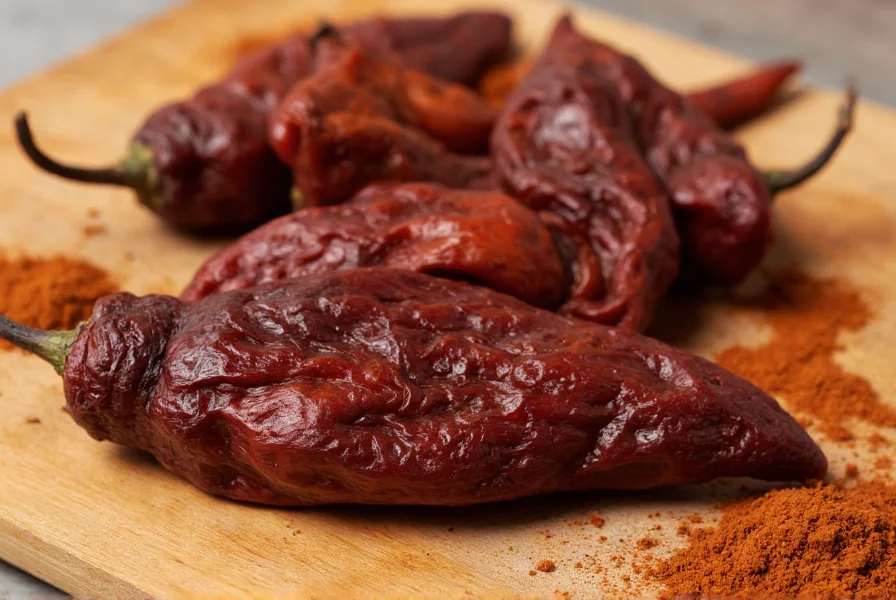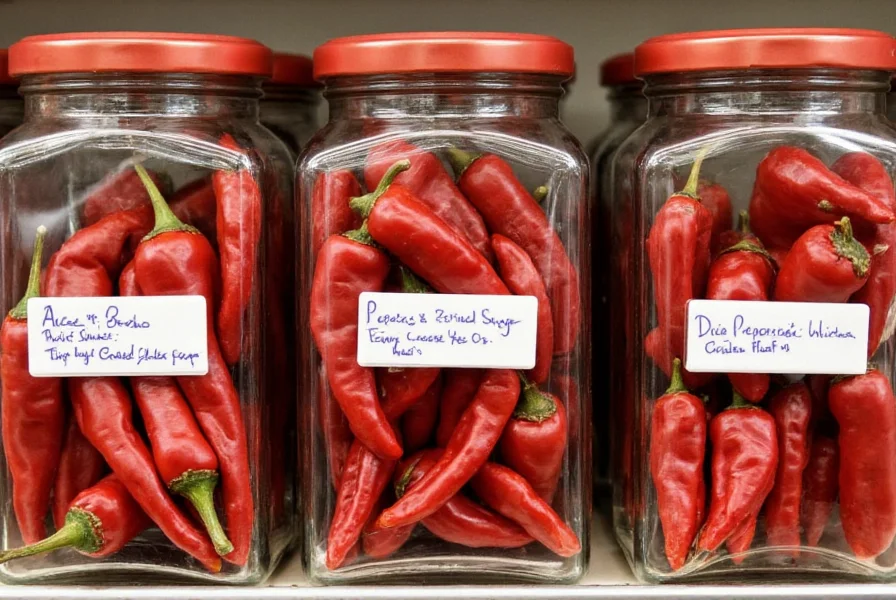An ancho pepper is a dried poblano pepper, known for its rich, slightly sweet flavor with notes of dried fruit, coffee, and chocolate. This mild to medium-heat chili (1,000-2,000 Scoville units) originates from Mexico and serves as a cornerstone in traditional Mexican cuisine, particularly in mole sauces, salsas, and stews.
Understanding what is an ancho pepper begins with recognizing its transformation from fresh to dried form. When poblano peppers mature on the vine and turn deep red, they're harvested and sun-dried, becoming anchos. This drying process concentrates their natural sugars while developing complex earthy notes that distinguish them from their fresh counterparts.
Many home cooks confuse ancho pepper vs poblano, but the distinction is simple: poblano refers to the fresh green pepper, while ancho describes the same pepper after drying. This transformation changes not only the appearance but also the flavor profile and culinary applications.
Physical Characteristics and Heat Profile
Ancho peppers measure 3-6 inches long with a distinctive heart-shaped appearance and wrinkled, mahogany-brown skin. Their heat level registers between 1,000-2,000 Scoville Heat Units (SHU), placing them milder than jalapeños (2,500-8,000 SHU) but with more complexity than bell peppers (0 SHU).
| Pepper Type | Scoville Heat Units | Flavor Profile |
|---|---|---|
| Ancho Pepper | 1,000-2,000 | Smoky, sweet, raisin-like |
| Jalapeño | 2,500-8,000 | Grassy, bright, sharp |
| Guajillo | 2,500-5,000 | Tangy, berry-like |
From Garden to Kitchen: The Ancho Pepper Journey
The journey of what is an ancho pepper starts with the poblano plant, which thrives in warm climates with well-drained soil. After reaching full maturity and turning from green to deep red (typically 65-80 days after planting), farmers harvest the peppers for drying. Traditional sun-drying takes 3-5 days, though commercial producers often use dehydrators for consistency.
During this drying process, the poblano undergoes significant chemical changes. Enzymatic browning reactions develop the characteristic deep color, while natural sugars caramelize, creating the distinctive sweet notes that make anchos so valued in Mexican cooking.

Culinary Applications of Ancho Peppers
Chefs prize dried ancho peppers for their versatility in creating complex flavor bases. Before using, most recipes require rehydrating the peppers by soaking in hot water for 15-20 minutes until pliable. Once softened, they blend smoothly into sauces or can be seeded and chopped for texture.
Traditional applications include:
- Mole poblano (the signature sauce of Puebla, Mexico)
- Adobo marinades for meats
- Enchilada sauces and salsas
- Spice rubs for grilled proteins
- Flavor enhancer in soups and stews
Finding Suitable Ancho Pepper Substitutes
When you need an ancho pepper substitute, consider these alternatives based on availability and desired flavor profile:
- Guajillo peppers: Similar mild heat with brighter, tangier notes
- pasilla peppers: Earthier flavor with comparable heat level
- Chipotle powder + sweet paprika: For smoky depth with sweetness (use 1:2 ratio)
- Smoked paprika + a touch of cayenne: Quick pantry substitute
Remember that no substitute perfectly replicates the unique sweet-earthy balance of authentic ancho peppers, but these alternatives work well in most recipes calling for how to use ancho peppers.
Proper Storage Techniques
To maintain freshness and flavor, store dried ancho peppers in an airtight container away from light and moisture. Properly stored in a cool, dark pantry, they'll retain quality for 6-12 months. For extended storage, place them in the freezer where they'll stay flavorful for up to 2 years.
Before using older peppers, check for signs of deterioration: musty smells, excessive brittleness, or mold. Fresh anchos should have a pleasant, slightly sweet aroma and flexible texture when rehydrated.

Nutritional Benefits of Ancho Peppers
Beyond their culinary value, ancho pepper nutrition offers several health benefits. Like other chili peppers, anchos contain capsaicin (though in milder concentrations), plus significant amounts of:
- Vitamin A (from beta-carotene): Essential for vision and immune function
- Vitamin C: Powerful antioxidant supporting skin health
- Vitamin B6: Important for metabolism and brain health
- Dietary fiber: Supports digestive health
- Iron: Crucial for blood health
These nutrients remain largely intact through the drying process, making ancho peppers a flavorful way to boost the nutritional profile of your dishes.
Where to Source Quality Ancho Peppers
Finding authentic where to buy ancho peppers requires attention to quality markers. Look for:
- Deep, uniform mahogany color (avoid pale or unevenly colored peppers)
- Flexible texture when gently bent (excessively brittle peppers may be stale)
- Distinctive sweet-earthy aroma
- Minimal stem pieces or foreign matter
Mexican grocery stores typically offer the freshest selection, but well-stocked supermarkets and reputable online spice retailers also carry quality dried anchos. When possible, buy whole peppers rather than pre-ground powder for maximum flavor retention.
Are ancho peppers the same as poblano peppers?
Ancho peppers are dried poblano peppers. When fresh poblano peppers mature to red and are dried, they become anchos. The drying process transforms both the flavor and texture, creating a milder, sweeter pepper with earthy notes compared to the grassier fresh poblano.
How hot are ancho peppers on the Scoville scale?
Ancho peppers range from 1,000 to 2,000 Scoville Heat Units, placing them in the mild to medium heat category. They're noticeably milder than jalapeños (2,500-8,000 SHU) but provide more complexity than bell peppers, which have zero heat.
What's the best way to rehydrate ancho peppers?
To properly rehydrate ancho peppers, remove stems and seeds, then submerge in hot (not boiling) water for 15-20 minutes until softened. For enhanced flavor, use broth, orange juice, or add a bay leaf to the soaking liquid. Never use boiling water as it can make peppers bitter.
Can I substitute ancho chili powder for whole ancho peppers?
Yes, but with adjustments. Substitute 1 whole dried ancho pepper with 1-1.5 teaspoons of ancho chili powder. Since powder lacks the texture of whole peppers, you may need to adjust liquid content in your recipe. For best results, make your own powder from quality dried anchos rather than using commercial blends that may contain fillers.
Why are my ancho peppers bitter?
Bitterness in ancho peppers usually comes from either using boiling water during rehydration (use hot, not boiling water) or leaving the white ribs and seeds intact. The seeds and inner membranes contain most of the capsaicin and can turn bitter when over-processed. Always remove seeds and ribs before use for optimal flavor.











 浙公网安备
33010002000092号
浙公网安备
33010002000092号 浙B2-20120091-4
浙B2-20120091-4